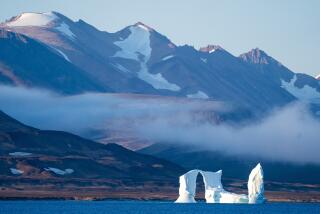Arctic sea ice reaches its smallest area ever, still shrinking
The area of floating sea ice in the Arctic has fallen to its lowest size ever observed, researchers said Monday. Moreover, the ice is still shrinking and is not expected to reach its minimum until sometime in September. The average shrinkage of the ice has been increasing steadily since 2007, and researchers attribute the loss to global warming, which is causing warmer temperatures in the region.
On Monday, the extent of the Arctic sea ice was 1.58 million miles, which is 27,000 square miles below the previous record set on Sept. 18, 2007, according to researchers from the University of Colorado’s National Snow and Ice Data Center. That is about 1 million square miles lower than the average minimum extent observed between 1979 and 2000 -- an area about the size of Alaska and Texas combined.
“It’s a little surprising to see the 2012 Arctic sea ice extent in August dip below the record low 2007 sea ice extent in September,” said climatologist Walt Meier of the center. “It’s likely we are going to surpass the record decline by a fair amount this year by the time all is said and done.”
The Boulder, Colo., team said that the old, thick multi-year ice that used to dominate the Arctic region has been largely replaced by young, thin ice that survives only one or two melt seasons. Since 1979, the September sea ice minimum has fallen by 12% per decade. The team predicts that the Arctic will be ice-free in the summer within the next several decades.
Climatologists say the Arctic sea ice is important because it keeps the polar region cold and helps moderate global climate. Some researchers call it the “Earth’s air conditioner.” The bright surface of Arctic ice reflects about 80% of sunlight back into space. The surrounding water, however, absorbs 90% of the sun’s warmth striking it. As the ice pack shrinks, the water absorbs more heat, increasing temperatures in the region and accelerating the melting of the ice in a feedback loop.
More information is available here.
Twitter/@LATMaugh






